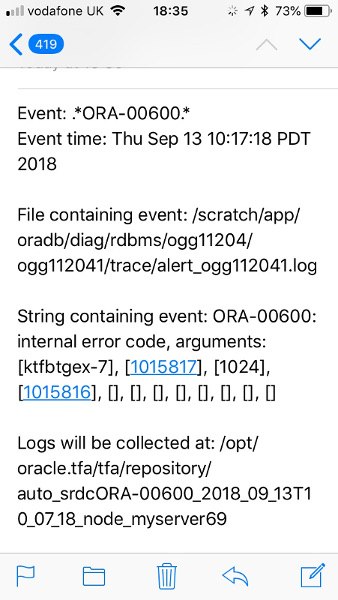- User’s Guide
- Collecting Diagnostic Data and Triaging, Diagnosing, and Resolving Issues
- Using Automatic Diagnostic Collections
- Configuring Email Notification Details
13.2 Configuring Email Notification Details
Configure Oracle Trace File Analyzer to send an email to the registered email address after an automatic collection completes.
To configure email notification details:
- To set the notification email for a specific
ORACLE_HOME, include the operating system owner in the command:tfactl set notificationAddress=os_user:emailFor example:tfactl set notificationAddress=oracle:some.body@example.com - To set the notification email for any
ORACLE_HOME:tfactl set notificationAddress=emailFor example:tfactl set notificationAddress=another.body@example.com - Configure the SMTP server using
tfactl set smtp.Set the SMTP parameters when prompted.
Table 13-2 tfactl diagnosetfa Command Parameters
Parameter Description smtp.hostSpecify the SMTP server host name.
smtp.portSpecify the SMTP server port.
smtp.userSpecify the SMTP user.
smtp.passwordSpecify password for the SMTP user.
smtp.authSet the Authentication flag to true or false.
smtp.sslSet the SSL flag to true or false.
smtp.fromSpecify the from mail ID.
smtp.toSpecify the comma-delimited list of recipient mail IDs.
smtp.ccSpecify the comma-delimited list of CC mail IDs.
smtp.bccSpecify the comma-delimited list of BCC mail IDs.
smtp.debugSet the Debug flag to true or false.
Note:
You can view current SMTP configuration details using
tfactl print smtp. - Verify SMTP configuration by sending a test email using
tfactl sendmail email_address.If Oracle Trace File Analyzer detects that a significant error has occurred, then it sends an email notification as follows:
- Do the following after receiving the notification email:
- To find the root cause, inspect the referenced collection details.
- If you can fix the issue, then resolve the underlying cause of the problem.
- If you do not know the root cause of the problem, then log an SR with Oracle Support, and upload the collection details.
Parent topic: Using Automatic Diagnostic Collections
